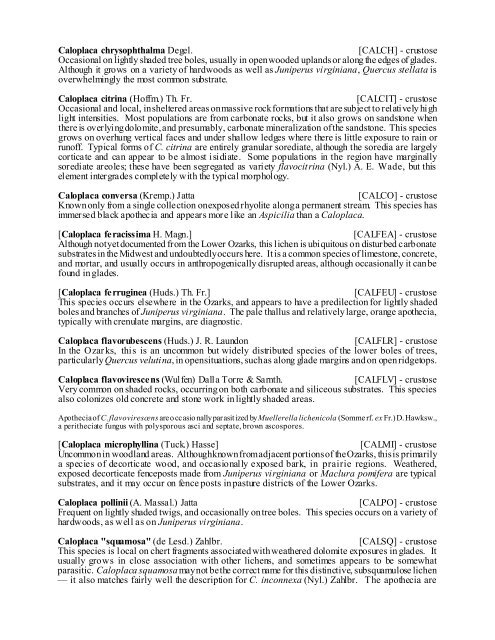lichens of the lower ozark region of missouri and arkansas
lichens of the lower ozark region of missouri and arkansas
lichens of the lower ozark region of missouri and arkansas
You also want an ePaper? Increase the reach of your titles
YUMPU automatically turns print PDFs into web optimized ePapers that Google loves.
Caloplaca chrysophthalma Degel. [CALCH] - crustose<br />
Occasional on lightly shaded tree boles, usually in open wooded upl<strong>and</strong>s or along <strong>the</strong> edges <strong>of</strong> glades.<br />
Although it grows on a variety <strong>of</strong> hardwoods as well as Juniperus virginiana, Quercus stellata is<br />
overwhelmingly <strong>the</strong> most common substrate.<br />
Caloplaca citrina (H<strong>of</strong>fm.) Th. Fr. [CALCIT] - crustose<br />
Occasional <strong>and</strong> local, in sheltered areas on massive rock formations that are subject to relatively high<br />
light intensities. Most populations are from carbonate rocks, but it also grows on s<strong>and</strong>stone when<br />
<strong>the</strong>re is overlying dolomite, <strong>and</strong> presumably, carbonate mineralization <strong>of</strong> <strong>the</strong> s<strong>and</strong>stone. This species<br />
grows on overhung vertical faces <strong>and</strong> under shallow ledges where <strong>the</strong>re is little exposure to rain or<br />
run<strong>of</strong>f. Typical forms <strong>of</strong> C. citrina are entirely granular sorediate, although <strong>the</strong> soredia are largely<br />
corticate <strong>and</strong> can appear to be almost i sidiate. Some populations in <strong>the</strong> <strong>region</strong> have marginally<br />
sorediate areoles; <strong>the</strong>se have been segregated as variety flavocitrina (Nyl.) A. E. Wade, but this<br />
element intergrades completely w ith <strong>the</strong> typical morphology.<br />
Caloplaca conversa (Kremp.) Jatta [CALCO] - crustose<br />
Known only from a single collection on exposed rhyolite along a permanent stream. This species has<br />
immersed black apo<strong>the</strong>cia <strong>and</strong> appears more like an Aspicilia than a Caloplaca.<br />
[Caloplaca feracissima H. Magn.] [CALFEA] - crustose<br />
Although not yet documented from <strong>the</strong> Lower Ozarks, this lichen is ubiquitous on disturbed carbonate<br />
substrates in <strong>the</strong> Midwest <strong>and</strong> undoubtedly occurs here. It is a common species <strong>of</strong> limestone, concrete,<br />
<strong>and</strong> mortar, <strong>and</strong> usually occurs in anthropogenically disrupted areas, although occasionally it can be<br />
found in glades.<br />
[Caloplaca ferruginea (Huds.) Th. Fr.] [CALFEU] - crustose<br />
This species occurs elsewhere in <strong>the</strong> Ozarks, <strong>and</strong> appears to have a predilection for lightly shaded<br />
boles <strong>and</strong> branches <strong>of</strong> Juniperus virginiana. The pale thallus <strong>and</strong> relatively large, orange apo<strong>the</strong>cia,<br />
typically with crenulate margins, are diagnostic.<br />
Caloplaca flavorubescens (Huds.) J. R. Laundon [CALFLR] - crustose<br />
In <strong>the</strong> Ozar ks, this is an uncommon but widely distributed species <strong>of</strong> <strong>the</strong> <strong>lower</strong> boles <strong>of</strong> trees,<br />
particularly Quercus velutina, in open situations, such as along glade margins <strong>and</strong> on open ridgetops.<br />
Caloplaca flavovirescens (Wulfen) Dalla Torre & Sarnth. [CALFLV] - crustose<br />
Very common on shaded rocks, occurring on both carbonate <strong>and</strong> siliceous substrates. This species<br />
also colonizes old concrete <strong>and</strong> stone work in lightly shaded areas.<br />
Apo<strong>the</strong>cia <strong>of</strong> C. flavovirescens are o ccasio nally parasitized by Muellerella lichenicola (Somme rf. ex Fr.) D. Hawksw.,<br />
a peri<strong>the</strong>ciate fungus with polysporous asci <strong>and</strong> septate, brown ascospores.<br />
[Caloplaca microphyllina (Tuck.) Hasse] [CALMI] - crustose<br />
Uncommon in woodl<strong>and</strong> areas. Although known from adjacent portions <strong>of</strong> <strong>the</strong> Ozarks, this is primarily<br />
a species <strong>of</strong> decorticate wood, <strong>and</strong> occasionally exposed bark, in prairie <strong>region</strong>s. Wea<strong>the</strong>red,<br />
exposed decorticate fenceposts made from Juniperus virginiana or Maclura pomifera are typical<br />
substrates, <strong>and</strong> it may occur on fence posts in pasture districts <strong>of</strong> <strong>the</strong> Lower Ozarks.<br />
Caloplaca pollinii (A. Massal.) Jatta [CALPO] - crustose<br />
Frequent on lightly shaded twigs, <strong>and</strong> occasionally on tree boles. This species occurs on a variety <strong>of</strong><br />
hardwoods, as well as on Juniperus virginiana.<br />
Caloplaca "squamosa" (de Lesd.) Zahlbr. [CALSQ] - crustose<br />
This species is local on chert fragments associated with wea<strong>the</strong>red dolomite exposures in glades. It<br />
usually grows in close association with o<strong>the</strong>r <strong>lichens</strong>, <strong>and</strong> sometimes appears to be somewhat<br />
parasitic. Caloplaca squamosa may not be <strong>the</strong> correct name for this distinctive, subsquamulose lichen<br />
— it also matches fairly well <strong>the</strong> description for C. inconnexa (Nyl.) Zahlbr. The apo<strong>the</strong>cia are


